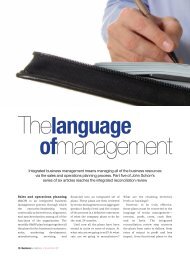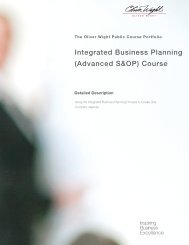The Proven Path - Oliver Wight Americas
The Proven Path - Oliver Wight Americas
The Proven Path - Oliver Wight Americas
You also want an ePaper? Increase the reach of your titles
YUMPU automatically turns print PDFs into web optimized ePapers that Google loves.
Strategicmanagement<br />
project that needs management’s<br />
attention is addressed. <strong>The</strong>se<br />
discussions typically involve<br />
resource requirements, schedule<br />
attainment, or other critical issues<br />
that require senior<br />
m a n a g e m e n t ’ s<br />
attention or approval.<br />
<strong>The</strong> output from<br />
the management<br />
review meeting is<br />
the approved plan,<br />
defining the decisions<br />
made and the agreed<br />
actions to be taken.<br />
This plan will be the<br />
input to the various<br />
departments for their<br />
selected gap closing<br />
scenarios.<br />
A quick review<br />
of the meeting’s<br />
minutes is made. <strong>The</strong><br />
minutes will move<br />
to the participants<br />
for action, to the<br />
process step leaders<br />
for direction, to the<br />
coordinators of the<br />
process steps for<br />
execution, and often to a broader<br />
audience (key suppliers or key<br />
customers) for alignment. Because<br />
of this broad distribution of the<br />
minutes and the impact that the<br />
decisions will have on the various<br />
departments, it is always good<br />
practice to review the minutes<br />
before they are published to<br />
ensure they accurately state senior<br />
management’s direction.<br />
A meeting critique is the final<br />
agenda item. <strong>The</strong> goal of the critique<br />
is to constantly strive to improve<br />
the decision-making capability of<br />
the sales and operations planning<br />
meeting. In this critique ask<br />
questions such as: Are we doing the<br />
right things How well are we doing<br />
them Are we on the right track to<br />
world-class performance <strong>The</strong>se<br />
are critical questions for evaluating<br />
your sales and operations planning<br />
process. <strong>The</strong> answers will reflect<br />
the current levels of performance<br />
and reveal significant opportunities<br />
for improvement.<br />
A good reference for critiquing the<br />
meeting is to follow a guide such as<br />
<strong>The</strong> <strong>Oliver</strong> <strong>Wight</strong> Class A Checklist<br />
for Business Excellence, Sixth<br />
Edition. Regular use of the checklist<br />
generates a consistent means of<br />
assessing progress, identifying<br />
problems, allowing early correction<br />
to those problems, and comparing<br />
performance against established<br />
best practices. By comparing<br />
performance against established<br />
best practices, your team will<br />
become motivated to work in a more<br />
effective manner.<br />
Colleen Crum, a managing<br />
principal of <strong>Oliver</strong> <strong>Wight</strong> <strong>Americas</strong>,<br />
recently conducted a survey of forty<br />
companies to determine the range<br />
of benefits various companies have<br />
achieved since implementing a sales<br />
and operations planning process.<br />
<strong>The</strong> results are impressive, and<br />
include:<br />
• Increased forecast accuracy<br />
18 – 25 percent<br />
• Increased sales revenue<br />
10 – 25 percent<br />
• Increased on-time delivery<br />
10 – 50 percent<br />
• Inventory reduction<br />
18 – 46 percent<br />
• Safety stock reduction<br />
11 – 45 percent<br />
• Increased productivity<br />
30 – 45 percent<br />
One executive recently confided to me:<br />
“For once I have a handle on the business.”<br />
You, too, can approach and even surpass<br />
these results, once you begin to follow the<br />
‘proven path’ to successfully implement<br />
the best practice S&OP process described<br />
in this six article series.<br />
John E. Schorr, a principal with <strong>Oliver</strong> <strong>Wight</strong>, is one of the leading experts in sales & operations planning<br />
(S&P). Prior to joining <strong>Oliver</strong> <strong>Wight</strong>, John was involved in the implementation of MRP II at Haworth, where<br />
he was vice president of manufacturing, and Steelcase, where he was director of purchasing.<br />
January 08 Businessexcellence 11
















